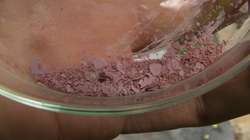Barium ferrate

| |
| Names | |
|---|---|
| IUPAC name
Barium ferrate
| |
| Systematic IUPAC name
Barium ferrate (VI) | |
| Properties | |
| BaFeO4 | |
| Molar mass | 257.17 |
| Appearance | Pinkish-brown powder |
| Odor | None |
| Melting point | decomposes |
| Insoluble | |
| Related compounds | |
| Related ferrates
|
potassium ferrate sodium ferrate |
| Except where otherwise noted, data are given for materials in their standard state (at 25 °C [77 °F], 100 kPa). | |
| Infobox references | |
Barium ferrate is a compound with a formula of BaFeO4. This is a stable barium salt of ferric acid, which itself is too unstable to exist in aqueous solution. It is a pinkish-brown crystalline or powder-like solid that is well known as the most stable ferrate and the easiest to synthesize and isolate. It is a strong oxidizer.
Contents
Properties
Physical
It is pinkish-brown powder that does not dissolve in water.
Chemical
It is a very potent oxidizer, but its insolubility makes it extremely stable for a ferrate. It is not known for decomposing just from contact with air, as potassium ferrate often does. It, however, reacts with acids stronger than ferric acid, such as all strong acids and several mid-strength acids such as phosphoric, liberating the extremely unstable ferric acid which is a powerful oxidizer.
Availability
Barium ferrate is not used in any household products, and reagent stores rarely sell it. However, it is easy to synthesize and isolate.
Preparation
There are several methods of ferrate synthesis. The most practical are the electrolytic method and the hypochlorite method. In the electrolytic method, a solution of an alkali metal hydroxide is electrolyzed with iron electrodes. In the hypochlorite method, salts of trivalent iron are oxidized with hypochlorites in solution.
In any case, if you have any form of solvated ferrate ion, you can immediately precipitate barium ferrate by adding any soluble barium compound. Barium ferrate does not react with filter paper in neutral and higher pH, so you can use it.
Handling
Safety
Barium ferrate is mostly non-toxic, being insoluble. The products of its decomposition, however, aren't so safe: it is prone to forming barium hydroxide or salts, which are toxic. Barium ferrate should not come in contact with flammable organic compounds.
Storage
Barium ferrate can be stored in any jar.
Disposal
Use sulfuric acid to neutralize barium ferrate. It will release oxygen from the compound and bind the toxic barium into the safe barium sulfate.